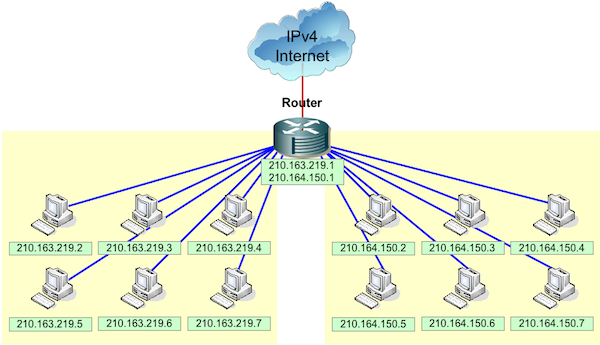Networking
Domain Name System (DNS)
The Internet Domain Name Service (DNS) is a key consideration in the transition of the Internet to IPv6.
DNS includes the architecture, servers, protocols, and data bases to translate internet host names to IP addresses. This service is essential for the functioning of name-based services such as accessing web sites or email addresses using domain names as part of Universal Resource Locators (URLs). Without DNS, we would have to keep a numeric directory of server IP addresses similar to the way we use numbers to make a telephone call.
The current IPv4 DNS service takes a host name such as www.bct-llc.com and converts it to its IP address:
71.178.251.89
allowing web request to be routed to the correct internet server. For the corresponding capability to be present on the IPv6 internet, we need a way to look up the IPv6 addresses.
In DNS, hostnames are mapped to IPv6 addresses by AAAA resource records, so-called quad-A records.
Root DNS Servers
The DNS servers that serve the top-level domains (TLDs) including the three-letter GOV, EDU, COM, MIL, ORG, NET, and the two letter country-code domains such as US, UK, FR, etc.
In March 2014, over 92% of the top-level domains (TLDs) in the Internet supported IPv6 to access their DNS servers, and over 91% of the DNS zones contained IPv6 records, but less than 4% of Internet domains had IPv6 address records.
IPv6 DNS Lookup
DNS usually is invoked indirectly by a user's computer as part of some other service such as accessing a web site or sending an email. It is possible to access DNS directly from a command line or terminal session. The exact command syntax depends on the user's operating system.
For example in a Microsoft Windows command window the command syntax is illustrated in the example below:
nslookup -type=AAAA ipv6.t-mobile.com ns1.t-mobile.com
In a Linux or Macintosh terminal window the corresponding example is slightly different:
nslookup -type=AAAA -server=ns1.t-mobile.com ipv6.t-mobile.com
Routing
The internet is a packet-switched network, over which interconnected systems communicate by routing data packets from the sources to their intended destinations. Routing is based on a shared knowledge of the Internet's topology and a set of routing protocols. These protocols include procedures for communicating and maintaining the locations of all internet IP addresses, the available routes interconnecting these addresses, and the decision rules for selecting the best route to use and when packets need to be retransmitted. As is illustrated in the internet diagram, the large number of internet addresses and the larger number of potential routes makes this a complicated task.
The difference in the density of the routes between IPv4 and IPv6 reflects the current smaller user population in IPv6. This will change as users transition to IPv6 and the Internet continues to grow. Two methods of reducing the complexity of routing are subnetting and summarization. Together these methods significantly reduce the number of addresses and routing tables that need to be communicated and stored by internet routers.
Subnetting

A subnet is a logical division of an IP network in which a group of computers share a common network prefix, i.e., the first (left) part of their IP addresses. All of the computers in a subnet can be located using the subnet prefix, rather than their individual address.
In the IPv4 protocol subnets can vary significantly to allow network administrators to optimize the utilization of their available stock of addresses. The figure illustrates two subnets:
210.163.219.0/24 and 210.164.150.0/24
This requires that a subnet mask be specified along with each IP address. The familiar subnet mask (e.g., 255.255.255.0) used in IPv4 to specify subnetting is not used in IPv6 where the subnet size is standardized by the IPv6 prefix. The prefix is the first part of the IPv6 address that indicates the subnet. Prefixes are used in IPv6 instead of the subnet masks in IPv4. Prefixes for IPv6 subnets, routes, and address ranges are expressed with the notation written in address/prefix-length notation. For example,
21DA:D3:0:2F3B::/64
Summarization
Summarization is a technique to reduce the size and complexity of the internet routing tables. With summarization, routes to groups of multiple contiguous subnets can be aggregated into a single summary route, further reducing the size of the routing tables. The ability to use summarization depends on having contiguous blocks of IP addresses that have been logically allocated within an organization's topology to avoid fragmented address assignments.
In the example above, if the router included all the subnets beginning with:
210.163.0.0/24 - 210.164.255.0/24
Summarization allows the routing tables to be grouped together for routing purposes.







